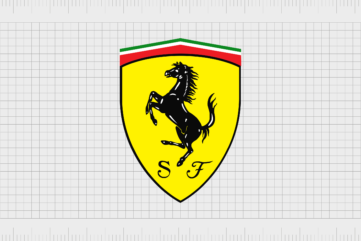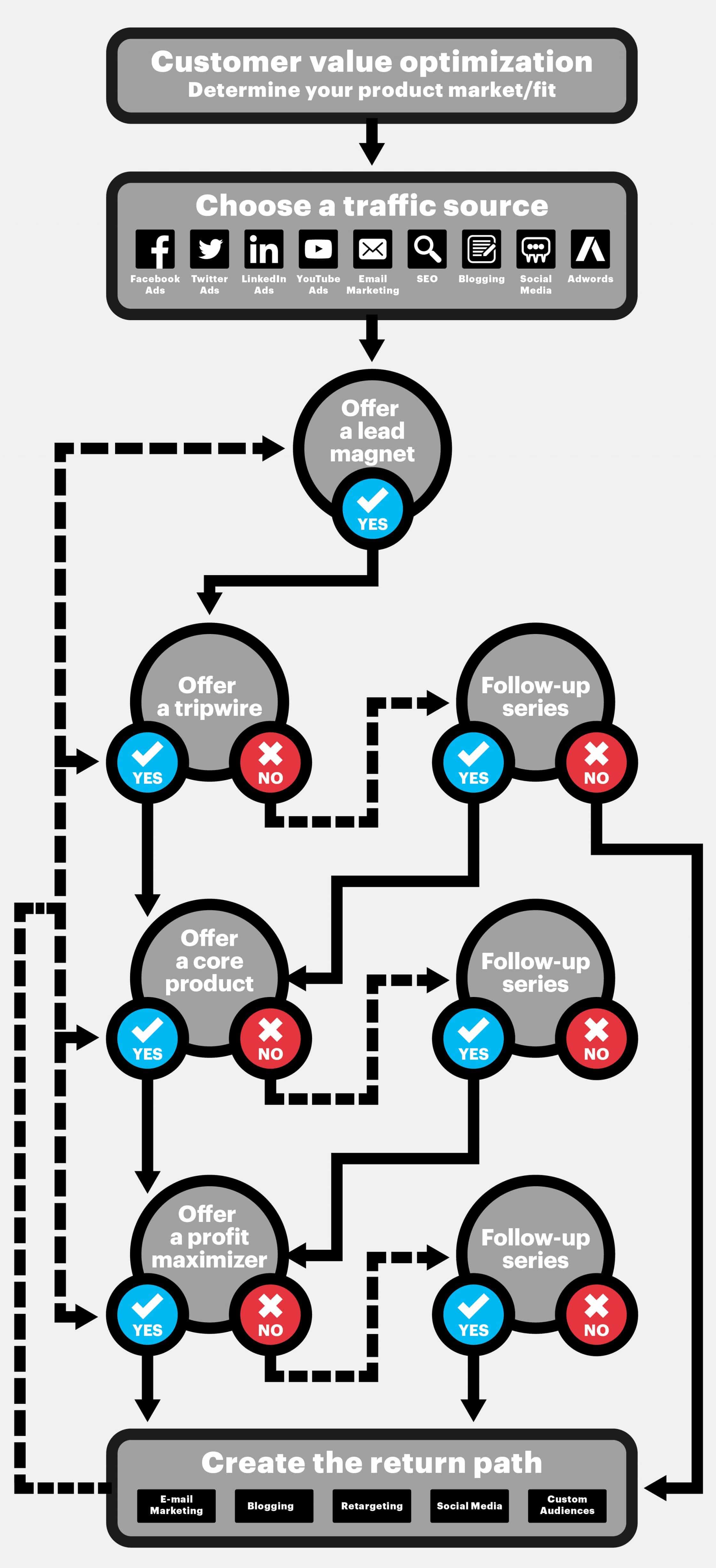The definitive guide to optimising your conversion funnel

Don’t get overwhelmed by the term “conversion funnel.”
If you sell something online, you already have a funnel. You’ve to optimise it to increase conversions and sales. Whether you’re an eCommerce marketer, a consultant, or SaaS entrepreneur I know that you’re always looking out for opportunities to have a high-converting funnel
So where do you begin and how do you optimise your conversion funnel like a pro?
In this detailed guide, you’ll get exclusive details on what a conversion funnel, what conversion optimisation entails, how to create a funnel, how to optimise it, access to resources, and expert tips and tricks.
If you haven’t read anything on funnel optimisation, this guide will be more than enough to put you on track. You’ll learn everything about conversion funnels and how to optimise them.
Let’s start with the basics.
What is a conversion funnel?
A conversion funnel is defined by Wikipedia as the journey that a potential customer takes before buying something from a website. The term funnel is used to denote the decrease in the number of visitors throughout the journey.
A visitor goes through different stages from being aware of the product all the way down to becoming a customer. A visitor experiences four stages before buying from you:
- Awareness
- Interest
- Desire
- Action

Not all the conversion funnels are created equal. You can add as many stages as possible. There are potentially no limits. You can create multiple funnels for different target segments or even for the same target segment.

The purpose of a conversion funnel is to:
- Generate new leads
- Convert leads into customers
- Convert these customers into lifetime customers by compelling them to buy more
To a large extent, every business has the same objective.
The difference is how you create and manage your funnel. Most businesses don’t have a conversion funnel but they know what they want to achieve.
Not every business optimises its funnel but it’s important they begin to do it.
Even if you never created one, you still have one. It’s just not optimised.
The stages of a conversion funnel
Every funnel its stages. These are the stages that a visitor must follow to take the desired action. Generally, there are four stages (as discussed above).
1). Awareness: The first stage where a visitor lands on your website for the first time. The purpose of this stage is to make visitors aware of your brand and products by clearly telling them how you can be of help.
2). Interest: This is the stage where a visitor shows their interest in your business and/or products. He might visit your product(s) page or maybe he visits About us page to find out more about you.
At this stage, you’ve to show visitors how your brand is different than your competitors. This is the time when you’ve to pitch your unique value proposition.
Not all the visitors move to Interest stage. Some of the visitors won’t be interested in your products and thus will leave the funnel after the awareness stage. This is totally fine. Don’t worry about it.
3). Desire: The stage where you develop a desire for your product(s) in the visitor. Clearly, communicate the benefits of your product and how it will help the visitors in solving their biggest challenge. Why should they buy from you?
Not all the visitors will show a desire to buy your products. There will be people who will be interested in your products but they won’t have that desire. So the number of visitors at this stage gets low.
4). Action: This is the stage where a visitor takes the necessary action: They move from being a visitor to become a lead or a buyer. It depends on your funnel and its objective. Do you want to collect email addresses or you want to convince people to buy your product?
Not everyone will take action. Most of the visitors will refrain to buy or will be hesitant to enter their email address so the number of actual people who will take action will be much lower.
The number of visitors entering a funnel is much higher as compared to those making it to the bottom (Action stage). There are leakages at every stage.

The actual number of people that will convert is significantly low unless you optimise your funnel.
What is conversion optimisation?
Let’s assume that 100 people entered your funnel. Here’s the breakdown:
- Only 50 moves to the next stage. (Interest stage)
- Out of these 50, another 25 leave the website when they browse your products. Some of them might not be interested in your products, others will be interested in buying from a competitor, etc.
- Only 5 visitors add at least one product in the cart.
- Out of these 5, only 3 check out and buy the product.
This means for every 100 visitors, you’ll have 3 sales while you’ll lose remaining 97 visitors. This means the conversion rate of your funnel is 3% or it converts at 3%.
Optimisation means to increase the conversions (i.e., results). The optimisation techniques focus on those 97% visitors that leave your website without buying.
Technically, conversion optimisation is the technique to increase the percentage of visitors that convert into customers.
Below is an imaginary store funnel that will help you better understand the leakages.
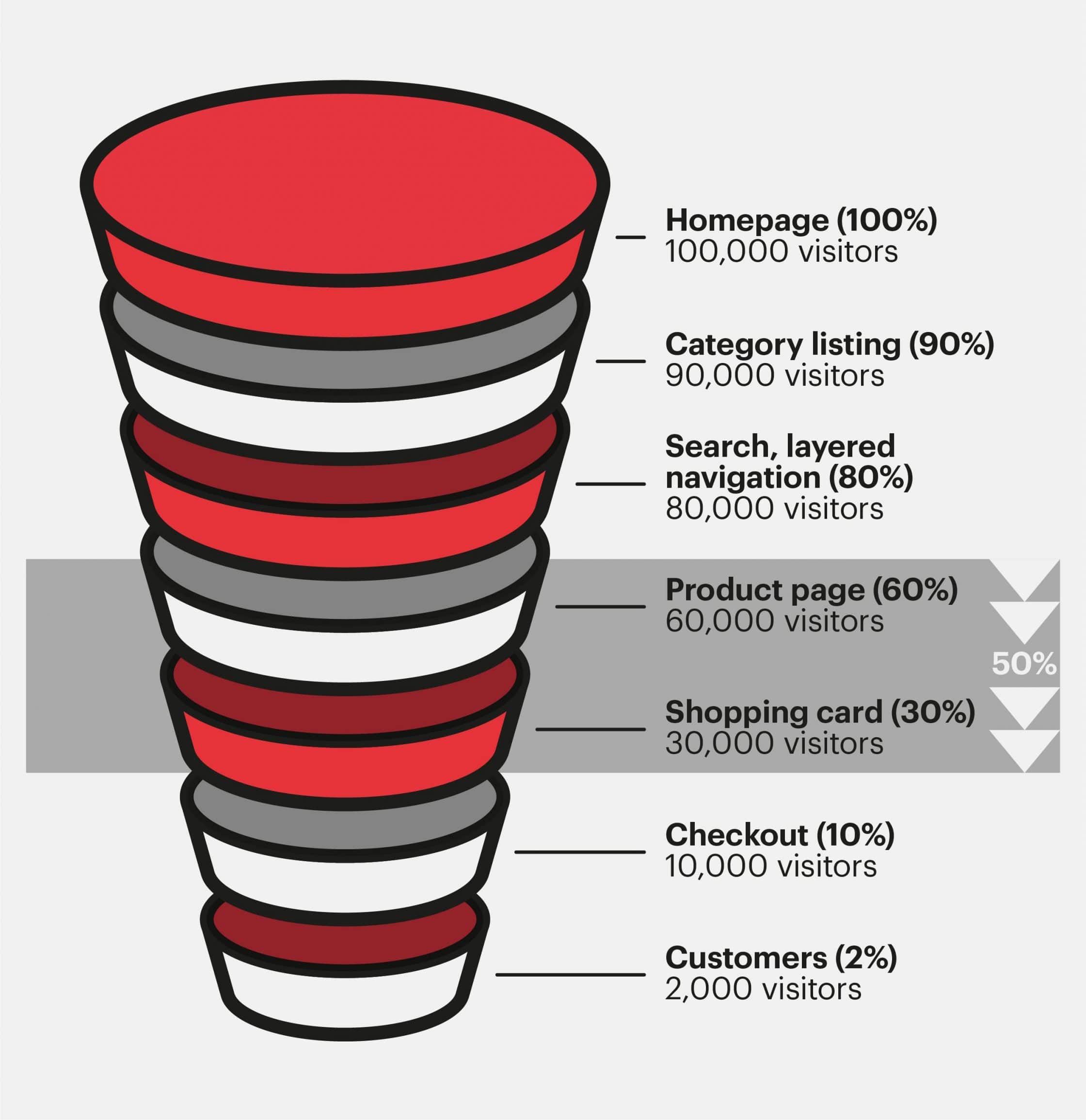
So why should you care about optimising your funnel?
Because conversion is directly related to ROI. A mere increase of a percent in conversion rate means you’re getting one new customer per 100 visitors.
The example below shows how a 1% increase in conversion will result in a 50% increase in sales (inquiries in this case, though).
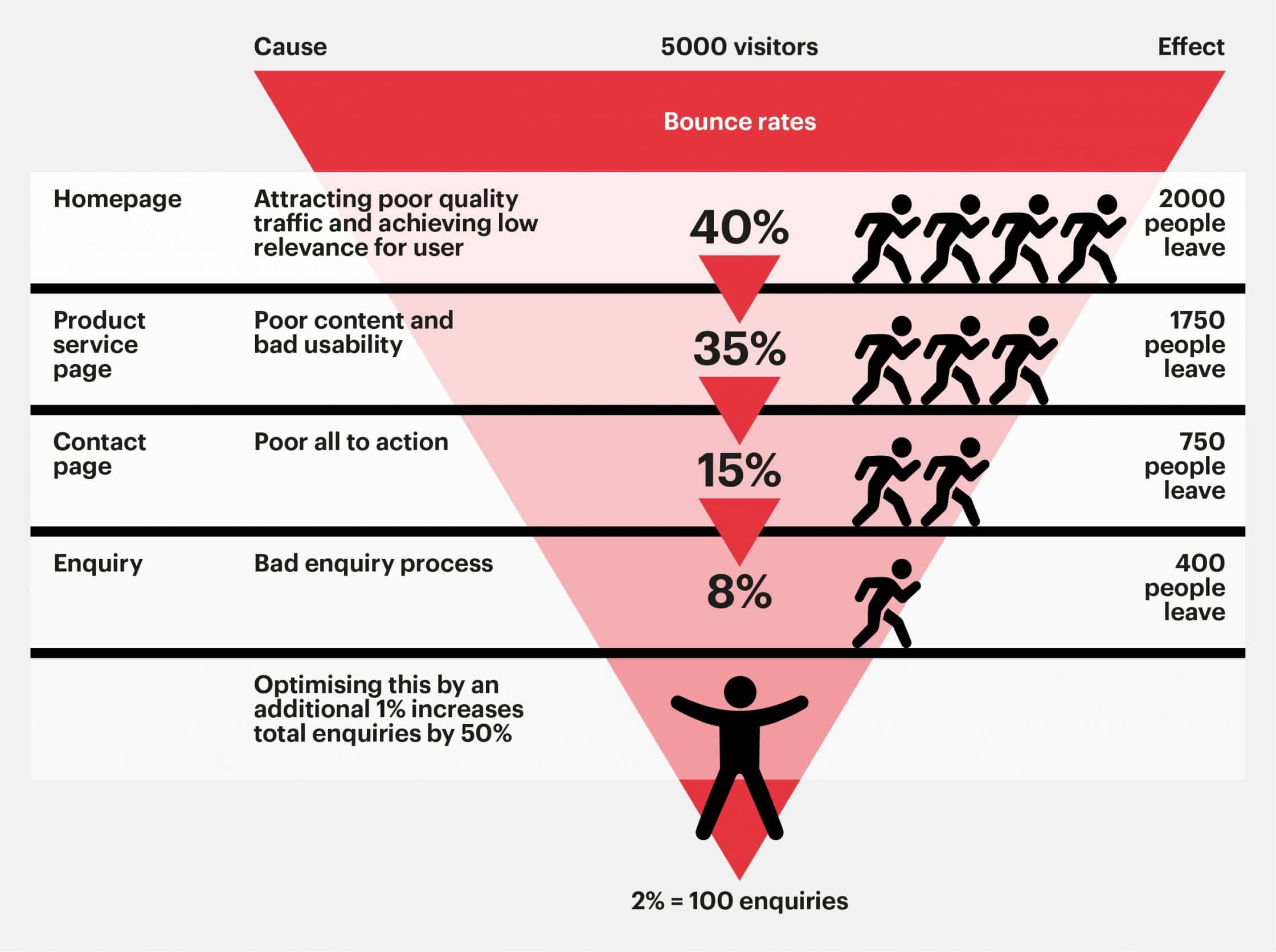
Here’s a case study:
Roller Skate Nation added FAQs to its product pages to answer customer queries related to their products. They tested two different versions of FAQs. In the first version, the FAQs were added right at the top of the product page and in the second version, the FAQs were added right after the Buy button. Version two resulted in an increase of 69% in conversion rate.
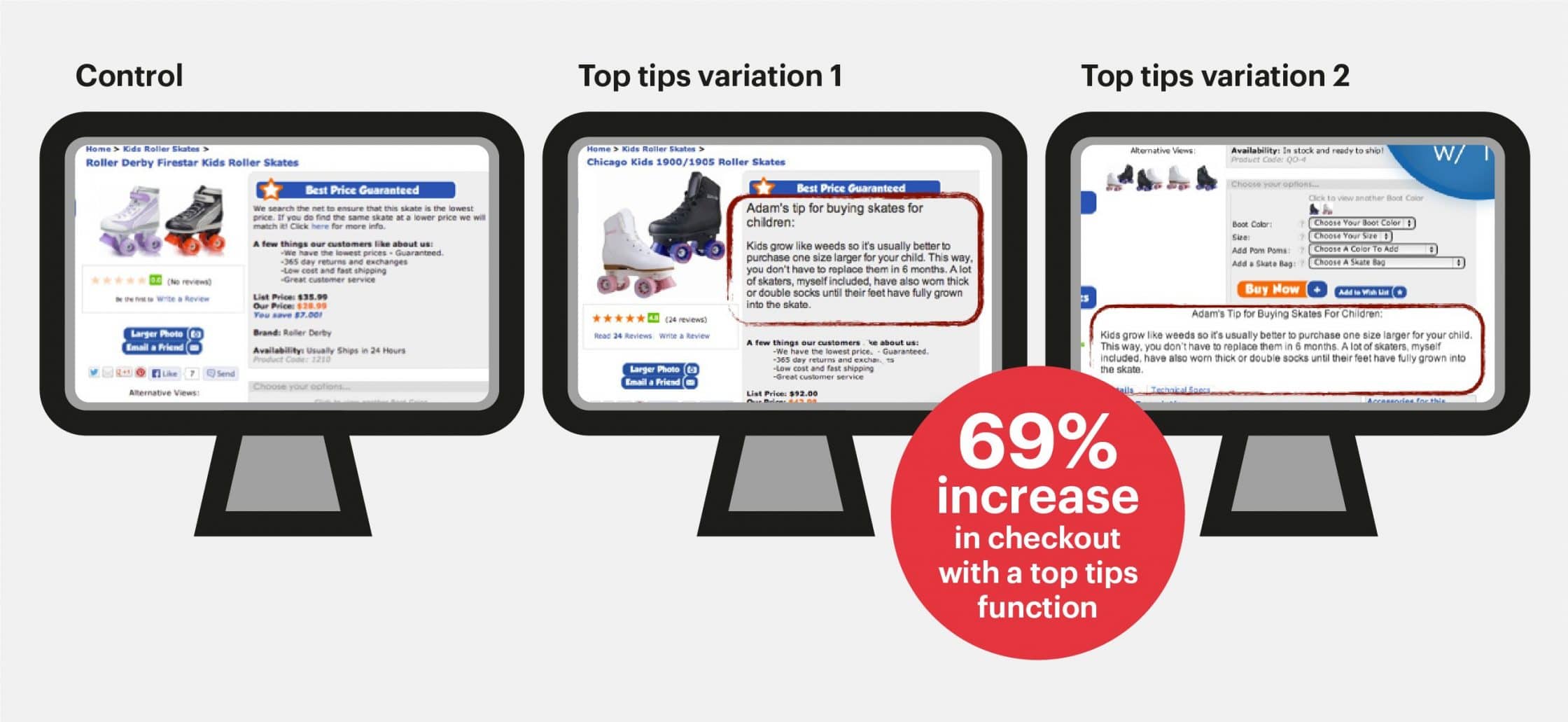
This is the reason why conversion optimisation is such a critical aspect of your funnel.
How to build a high-converting funnel
Before you can proceed with the funnel optimisation, you should have a funnel in place. Not just any funnel, but it has to be a high-converting funnel.
The first rule to optimising your conversion funnel is to have a high-converting funnel in place.
A high converting funnel is, by nature, optimised for conversions. Such a funnel will have a better conversion rate, by default, as compared to funnels that are not “high-converting.”
A high converting funnel has following parts/stages:
- A lead magnet
- A tripwire
- Core product/service
- A profit maximiser
- Return path

1. Lead magnet
A lead magnet is a free and specific irresistible bribe that offers the visitors value in exchange of their contact information such as email address.
GrooveHQ offers a free trial to its customers. This free trial is a perfect lead magnet.
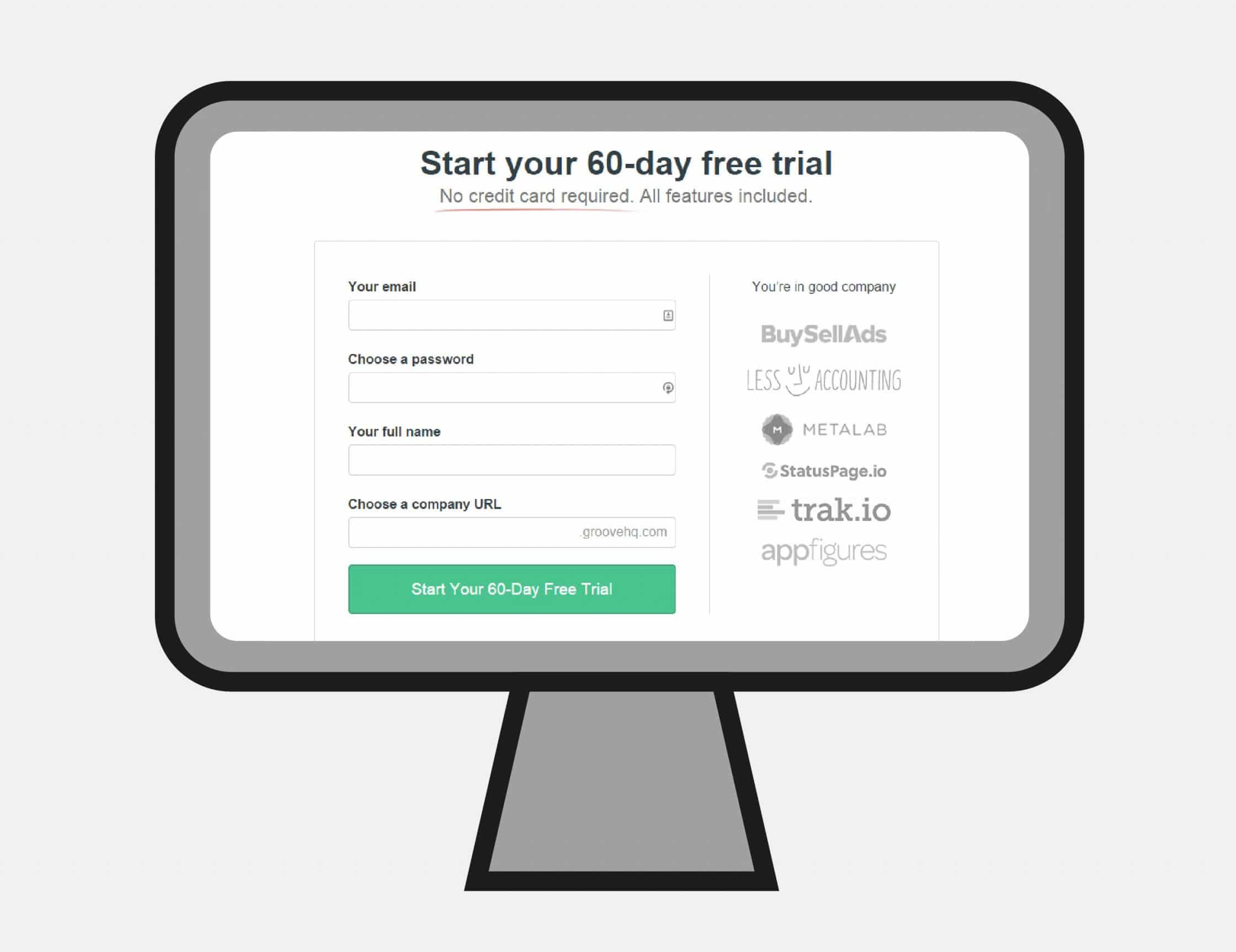
It’s valuable, irresistible, and absolutely free.
Instead of selling your core product on the landing page, creating a specific lead magnet to build your email list is a great idea. The conversions increase significantly when you offer a lead magnet on the landing page.
Laura from Intuitive Journal used lead magnets to acquire 43 leads a day. She tested multiple lead magnets and found one of them to be highly converting. It just offers an eBook to the visitors in exchange for their email address.
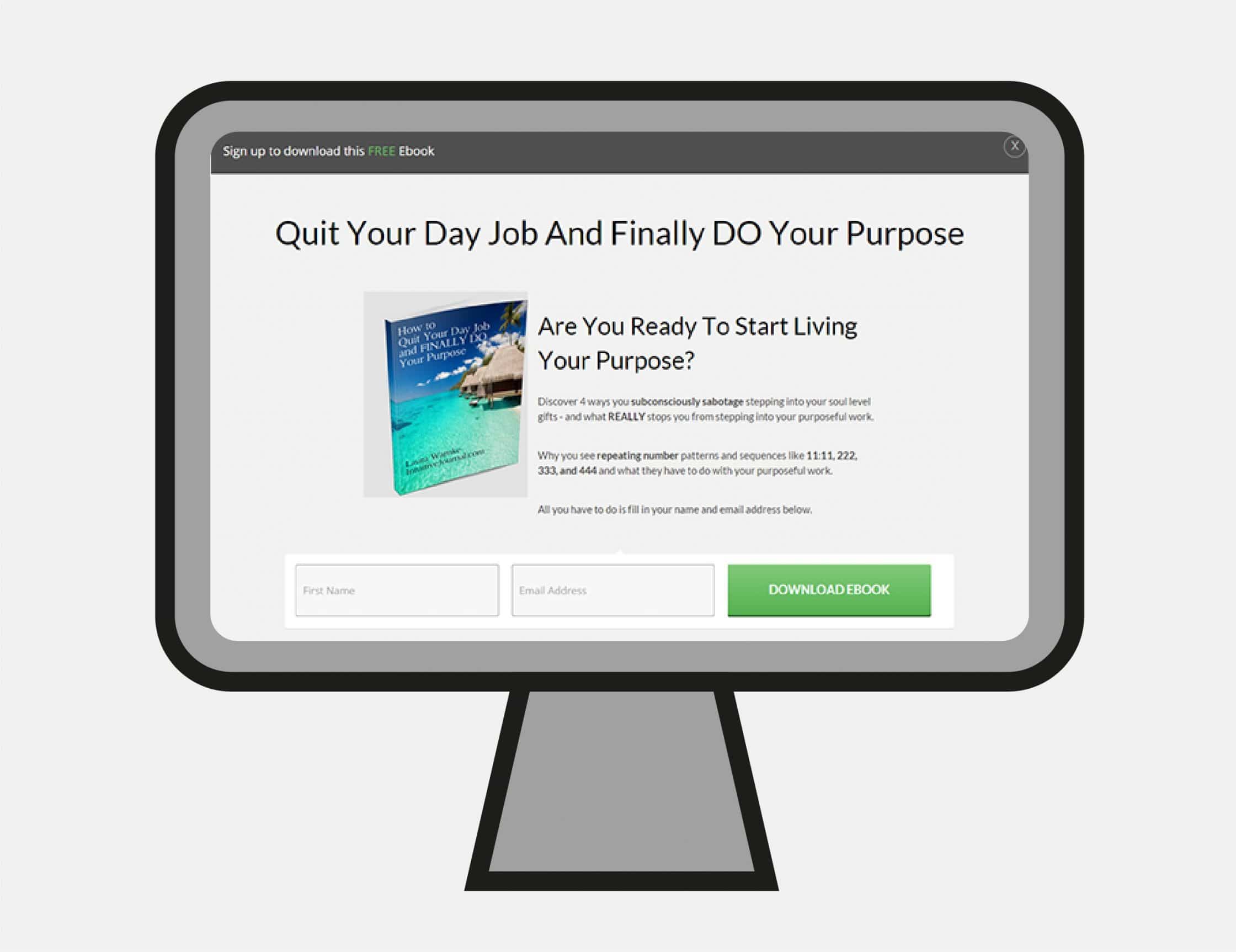
Once people subscribe, she can then pre-sell other products.
The Lead Magnet is the first stage of the conversion funnel. Those who opt for the lead magnet enters your funnel and move to the next stage (Tripwire). Those who don’t subscribe and refuse the offer are moved to the Return Path where they’re retargeted through other sources.
The purpose of using a lead magnet is to entice visitors to enter the funnel with a free offer. Get their contact details so you can contact them later. The lead magnet has to be extremely valuable or it won’t work.
There are different types of lead magnets that can be used to push visitors to your conversion funnel.
- Guides
- Case studies
- Cheat sheet
- Videos
- Resource kit
- Free trial/shipping
- Discount
- Survey
A perfect lead magnet:
- Is relevant
- Is specific
- Provides instant gratification
- Is free
- Is valuable
- Solves a problem
2. Tripwire
A tripwire is a low-cost offer that is used to convert a lead into a customer. This is the second stage in the conversion funnel.
The objective of a tripwire is to convert all those subscribers who opted for the lead magnet (through the funnel) into customers. This works because the subscribers know you and the product you’re offering them are inexpensive.
Anything under $10 is OK. Even if it’s priced at $1, it will work.
Remember, tripwire isn’t your core product. But rather, it’s an introductory product that’s offered at a very low price. The purpose of tripwire isn’t to make money but to convert leads into buyers, and recoup your investment, as it were.
Let me share an interesting case study here.
Authority Hacker used tripwire to collect 301 email subscribers in 30 days and earned $298.5 from the tripwire. This doesn’t sound too much. But they earned $2,376 from the same number of subscribers after they pitched them with their core product.
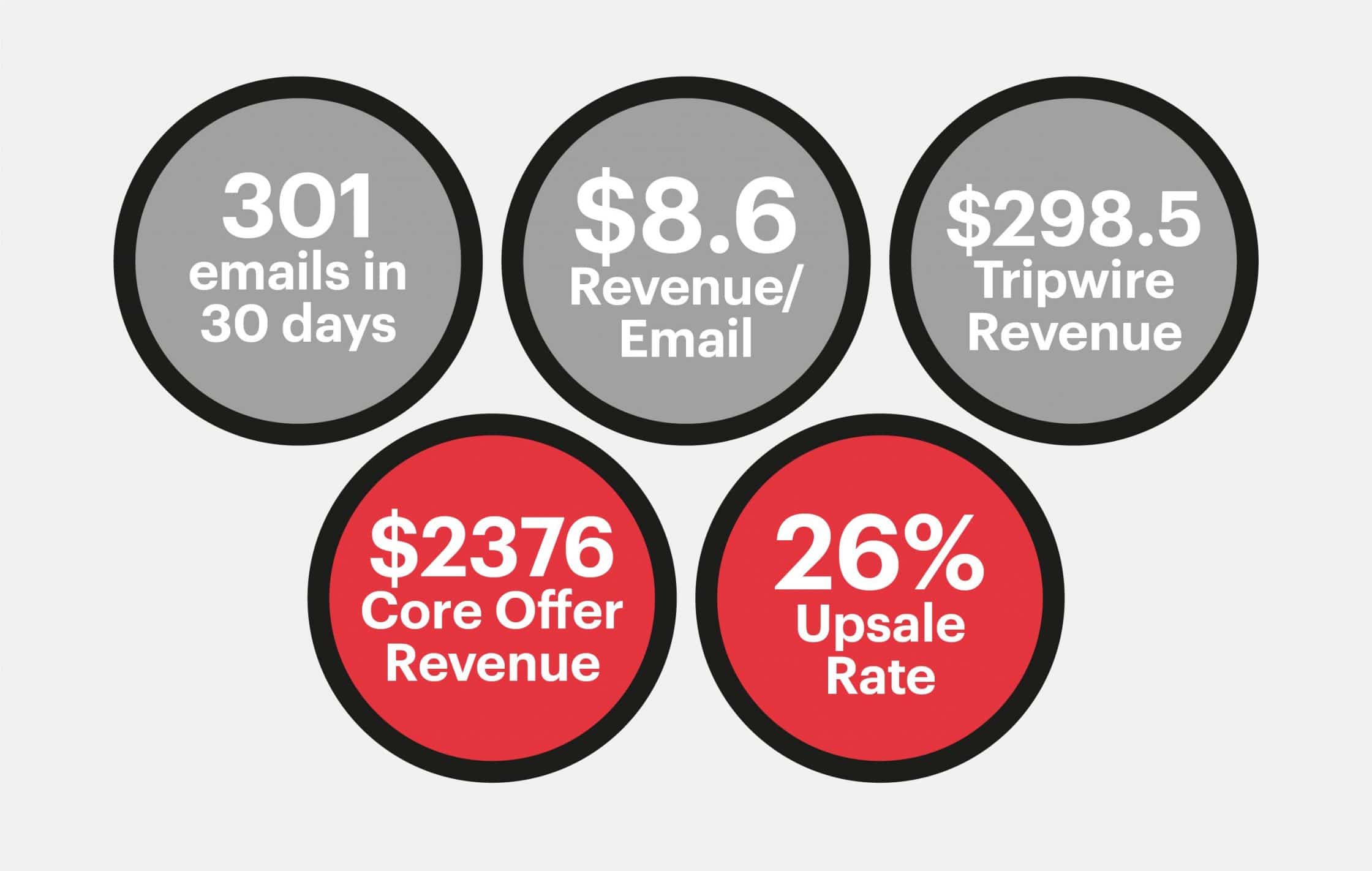
They used a rather simple conversion funnel. Only 30 subscribers purchased the tripwire and only 8 purchased the main product.

Should they have pitched the core product to these 301 people instead of a lead magnet, they wouldn’t have generated as many sales.
Tripwire can be an altogether a separate product, a part of your main product, or an old product offered at a low price.

The price of the tripwire should be extremely low and it should be of high value. The subscribers don’t have to think about it. They must have no other option but to buy the tripwire. This is how it will work.
Make it appealing and something they just cannot resist.
3. Core offer
This is the stage where you pitch the main product/service to all the subscribers who are customers after purchasing the tripwire. Since you’ve had two previous transactions with the subscribers, it’s highly likely that they will be interested in your main product.
It gets easier to sell when you have a previous connection with someone instead of throwing an expensive product to people who don’t even know you.
The price of the core product is much higher than the tripwire. Normally, 10-20x high.
Refer back to the Authority Hacker case study.
They made $2,376 from the core product and only $298.5 from the tripwire, however, 30 subscribers purchased tripwire while only 8 purchased the core product. But since core product was priced high, it worked.
The money is in the core product not in the tripwire.
4. Profit maximiser
Do you think that selling core product is all you need?
Rethink.
The profit maximiser is yet to come.
The profit maximiser is, as the name suggests, the product that maximises the profit. These are high-ticket products that are sold in the form of up-sells, cross-sells, and exclusive products.
The profit maximiser increases the average transaction value per customer and that’s where you earn real money.
Again, not everyone will be interested in buying the profit maximiser but don’t worry. Even a few sales will do.
See how Elegant Themes is using Lifetime Access as a profit maximiser, which is an up-sell. The price difference is huge and that’s the whole point. They will continue to pitch their profit maximiser to their customers inside the member’s area.

The fact of the matter is the probability of selling to existing customers is much higher (70%) as compared to selling to new people (20%).

Up-selling increases profitability. Period.

This is the reason why your funnel must be filled with up-sells and cross-sells.
An up-sell is a practice that encourages customers to buy high-end expensive products while a cross-sell is a selling technique that is used to sell related products.
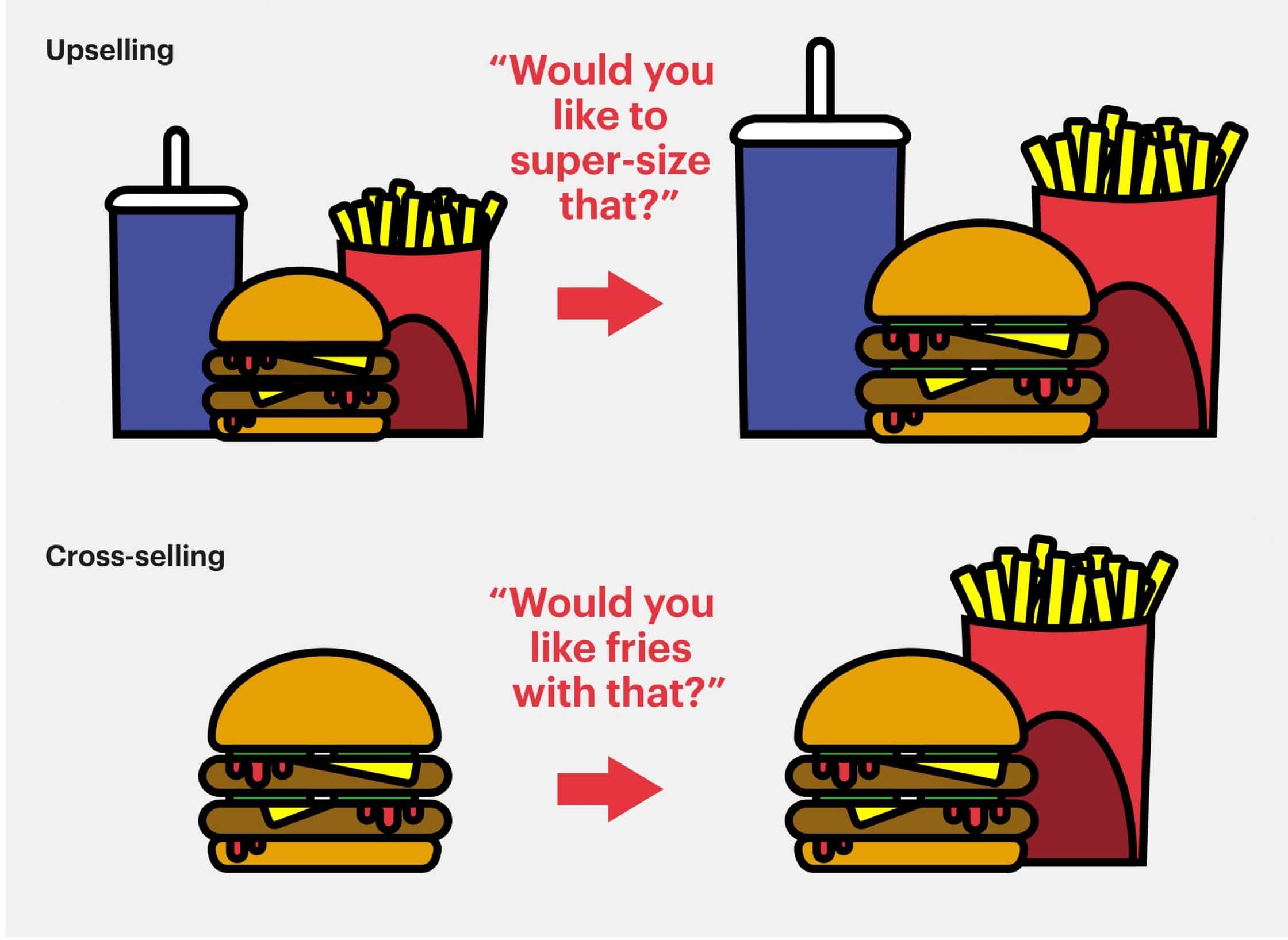
The purpose, in both cases, is to maximise profit and to increase average transaction value per customer.
5. Return path
This is not exactly a funnel stage rather a strategy to deal with the leakages.
Refer to the image shared earlier.
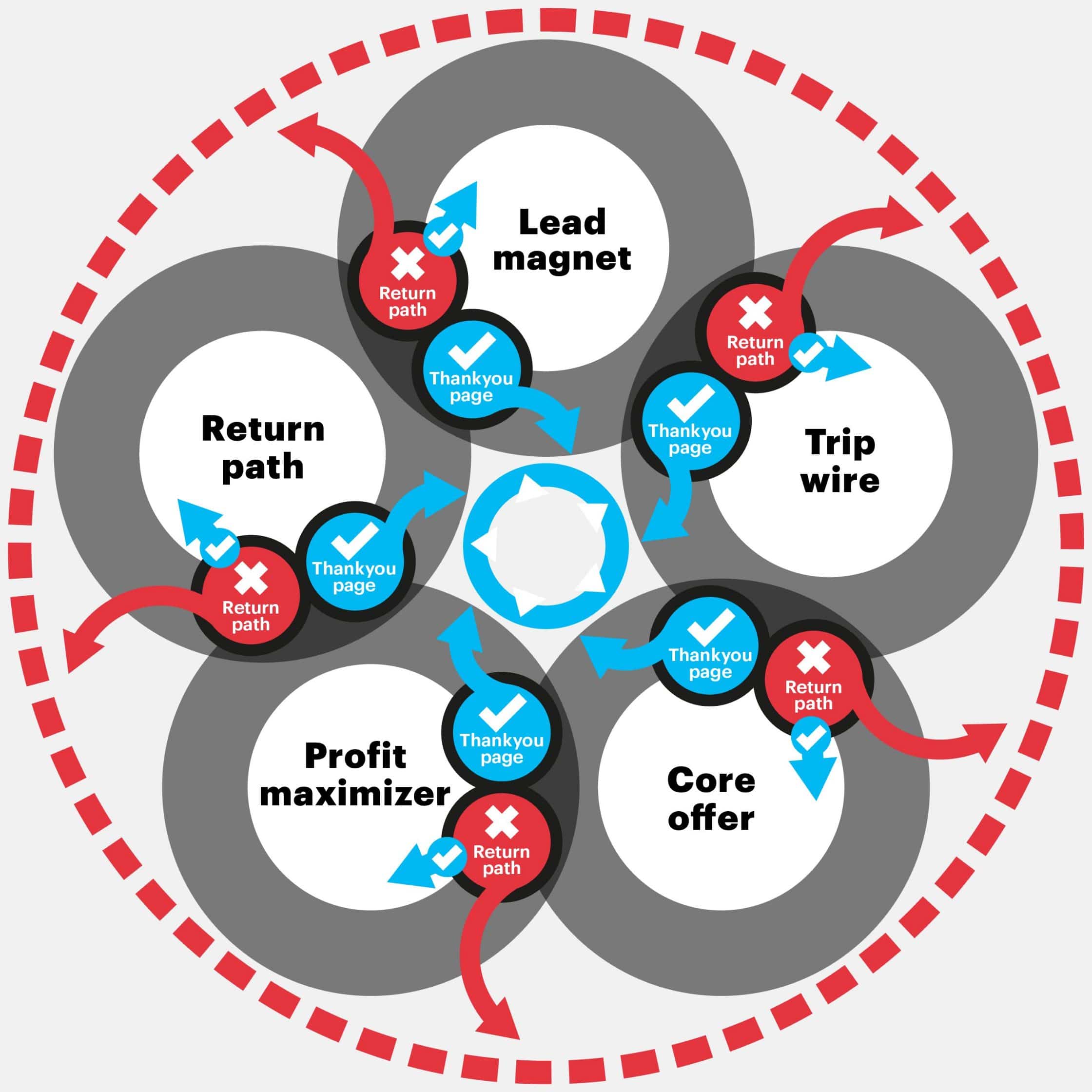
There will be visitors and customers throughout the funnel that will say No to your offers and products. For instance, not all the customers will buy the core offer and would prefer sticking to the tripwire. You just cannot leave them.
You’ve got to bring them back to the funnel so that they buy the core product (or tripwire or the profit maximiser).
This is why you need a return path that targets all the people who have at least one interaction with your business.
You can use:
- Retargeting campaigns to reach people who have been to your website but never took any action.
- Loyalty programs (to earn more from the existing customers who have purchased the profit maximiser, you cannot leave them).
- Autoresponders to communicate with the subscribers who signed up for the lead magnet but aren’t buying the tripwire.
- Content marketing to target all the different types of the target audience.
- Social media to build a relationship with the audience.
- Custom audience to target subscribers and buyers who have had an interaction with you.
Digital Marketer has a perfect funnel with traffic sources to put your business and funnel on autopilot.
Copy the same funnel and implement it exactly.
How to optimise the conversion funnel
The high-converting funnel that you just created works best for most of the businesses. But it isn’t optimised. Optimising the funnel will:
- Increase conversions
- Increase profit per customer
- Increase customer lifetime value
- Increase customer engagement
- Decrease funnel leakages
The following techniques, strategies, and resources will guide you to optimise your conversion funnel:
1. Use Google Analytics
The number one mistake marketers make is that they fail to measure and track funnel conversions. How well (or poor) it actually performs.
In order to be in a position to analyse your conversion funnel, you must track everything. The easiest and the free approach is to setting funnel in Google Analytics.
The Goals feature in Google Analytics is used to create events in the funnel and the funnel visualisation is used to analyse entire funnel.
Here is a brief guide on how to set up goals and visualisation in Google Analytics.
1. Create a New Goal after you’ve logged into your Google Analytics account. It’s found under the View column.
2. Setup your Goal. Add a description and choose an appropriate Type.
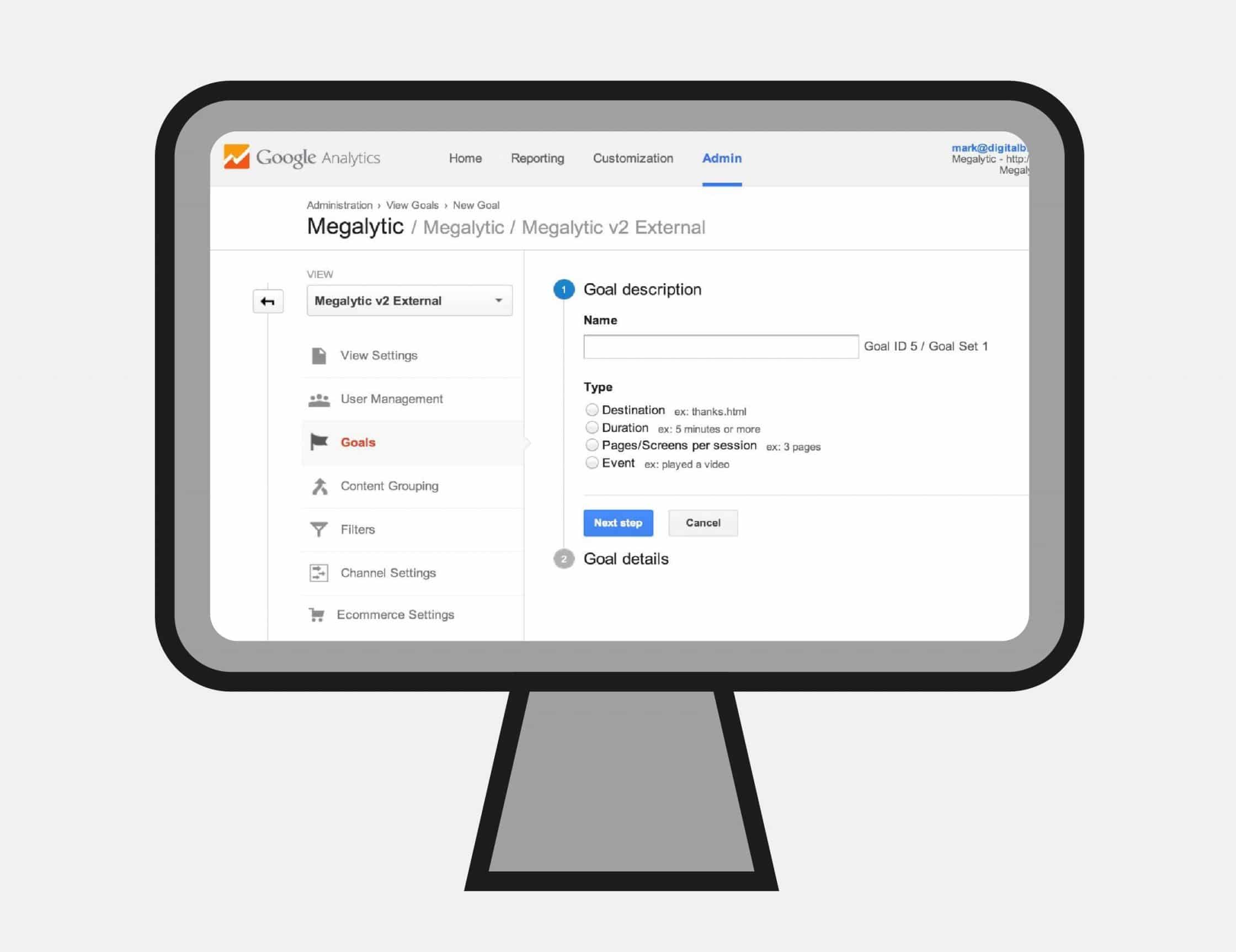
Destination: Used to track the percentage of visitors who reach a specific URL.
Visit Duration: Tracks the duration a visitor spends on the site.
Pages/Screens per sessions: Measures the number of pages a visitor visits per session.
Event: Advanced goal type that’s a bit technical.
3. Use Destination goal type as it is the most appropriate goal type of tracking funnel events and stages.
4. Enter appropriate values for the Goal details. Enter the destination URL that you wish to track in the funnel.

Create goals for all the events throughout your funnel.
You can then track each goal by visiting the Goals tab in your Google Analytics account. See how detailed it is and it shows conversion rates and the actual number of visitors.
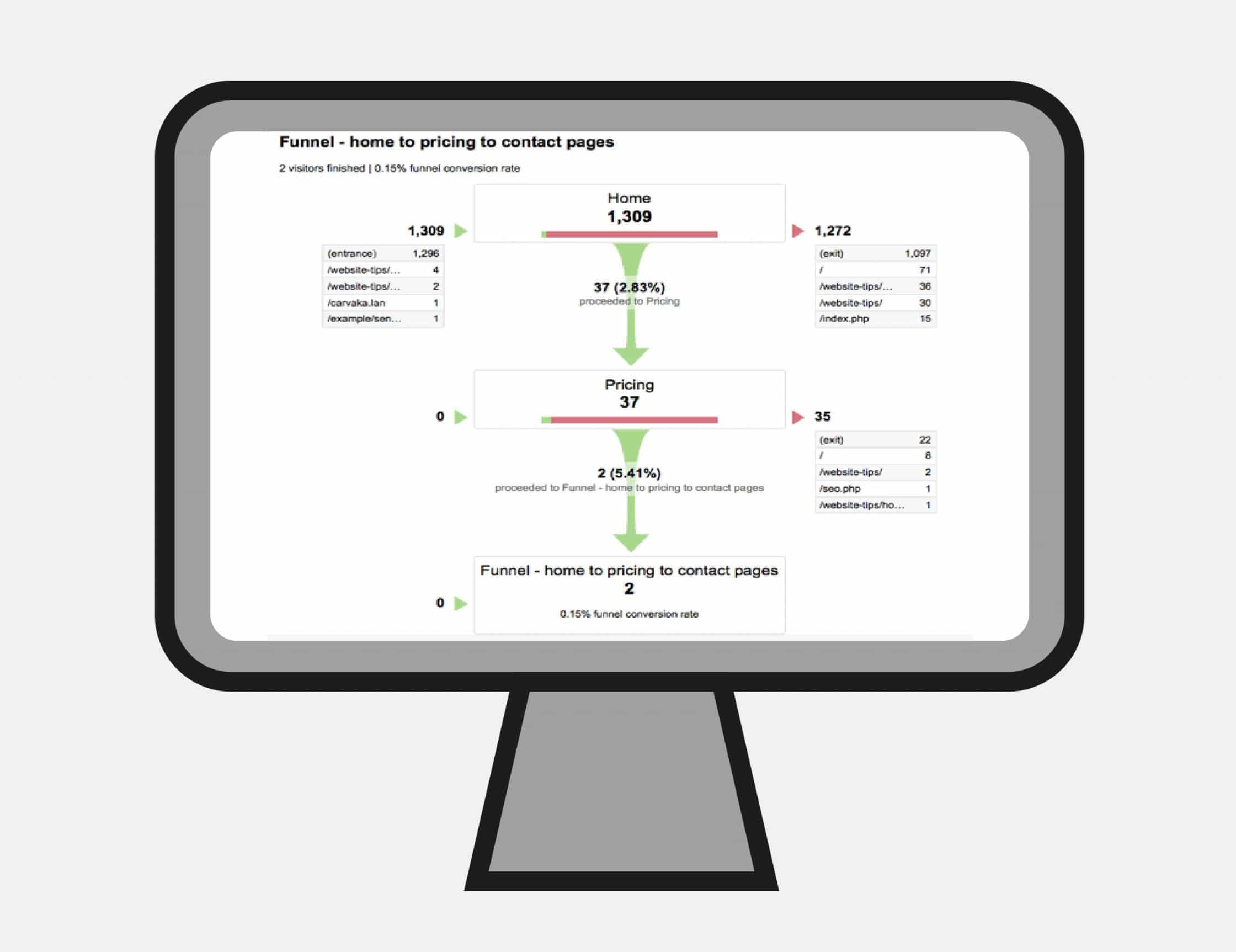
These goals and funnel visualisation provide you with insights that can be used to optimise your funnel.
For instance, if there are a lot of people leaving your website from a specific stage in the funnel, you need to fix it. Figure out what the reason is and fix it.
This helps you in finding and fixing the leaks in your funnel.
2. Optimise landing page
The funnel visualisation shows that a lot of visitors leave your website from the landing page. What are you supposed to do?
The obvious answer is to optimise the landing page.
A landing page is a dedicated page on your website that new visitors go to. According to HubSpot, there are two critical elements on a landing page that make it special:
- A form.
- The purpose of the landing page is to capture visitor information only.
Here are the examples of web pages that aren’t landing pages because they don’t have any form.
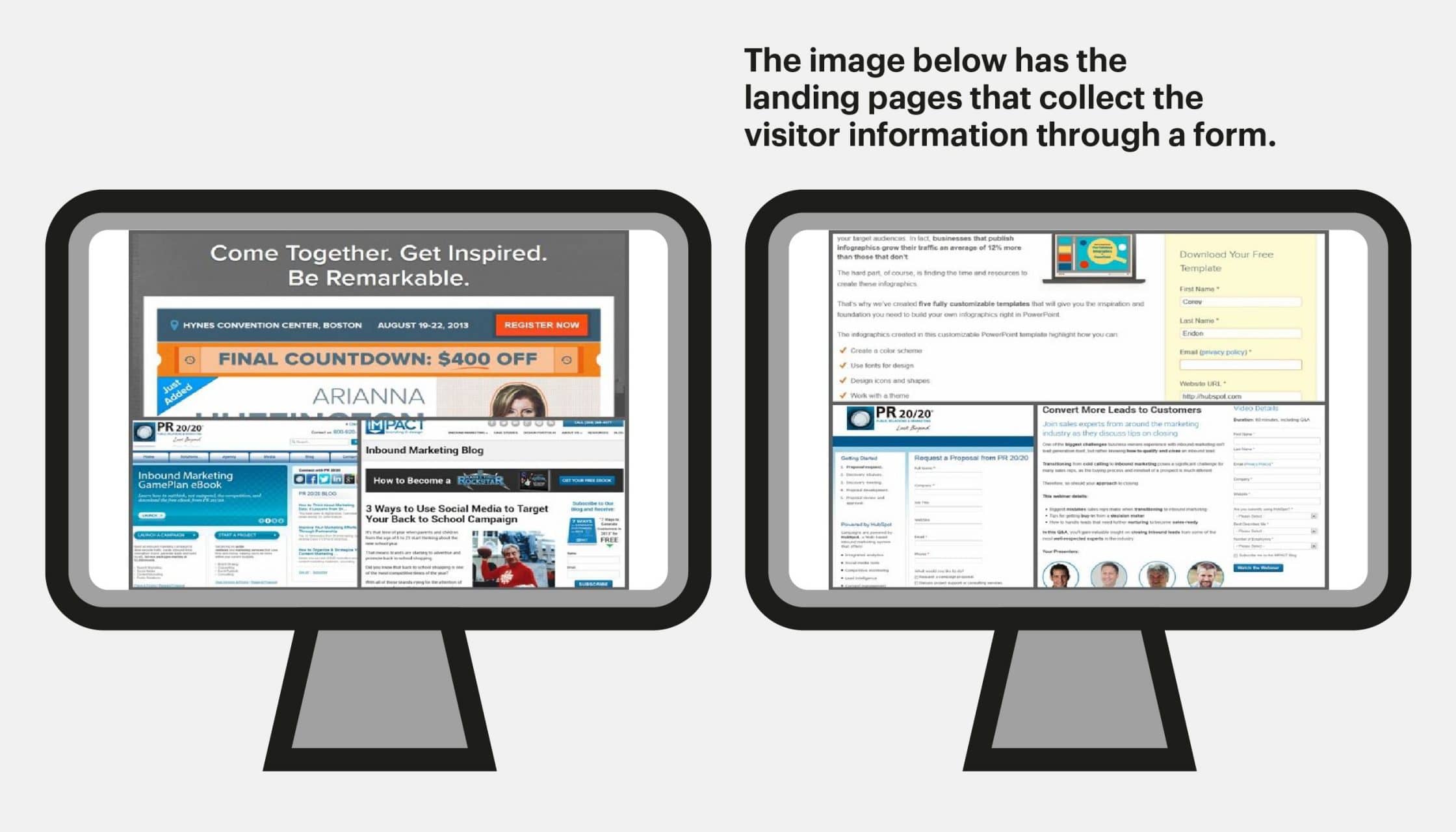
You need a landing page to share the lead magnet with the visitors.
You don’t need a landing page to sell the tripwire, core product, and up-sells because you’ve already collected the information about the subscribers. They’re on your list.
Landing page provides visitors access to your funnel and thus, it is one of the most crucial parts of the conversion funnel.
If visitors aren’t converting (not taking the desired action), your landing page needs to be tweaked and optimised. It has the magical power to boost conversion rate.
Zen Windows was seeing a conversion rate of 0.75% with their old landing page.
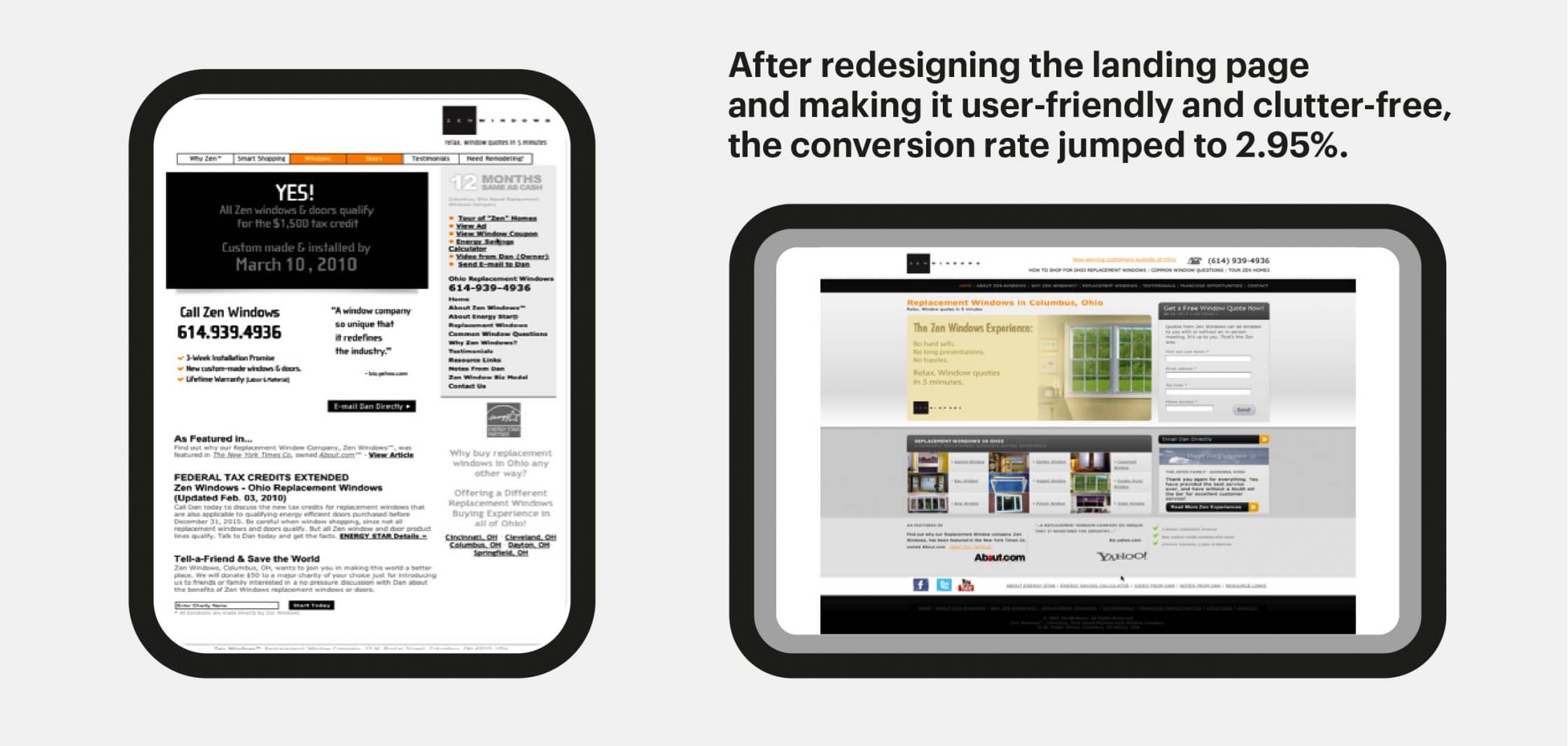
Redesigning your landing page is the first step when it ceases to show a decent conversion rate. There are 9 elements to redesign:
- Headline
- Description
- CTA
- Social proof
- Navigation
- Image/Video
- Benefits and features
- Third-party verification
- Above the fold

Of course, the landing page content has to be relevant to the ad and the lead magnet must be relevant to visitor’s expectation.
Follow these 25 landing page optimisation tips to make your landing page one of the best in the market. Above all, you should make your website mobile responsive. And for that to happen, you don’t only need a mobile friendly site, but also an epic mobile marketing strategy.
Once you have a landing page that’s working, it has to be tested and tweaked. If it isn’t working for some reason, you can’t change it altogether rather one element has to be changed at a time to see how the change impacts the conversion rate. This is known as A/B testing.
Follow these guidelines for effective A/B testing:
- One test at a time.
- Tweak one variable at a time.
- Measure minor as well as major elements.
In the example below, changing the “order” to “get” on the CTA button increased conversion by 14.79%.
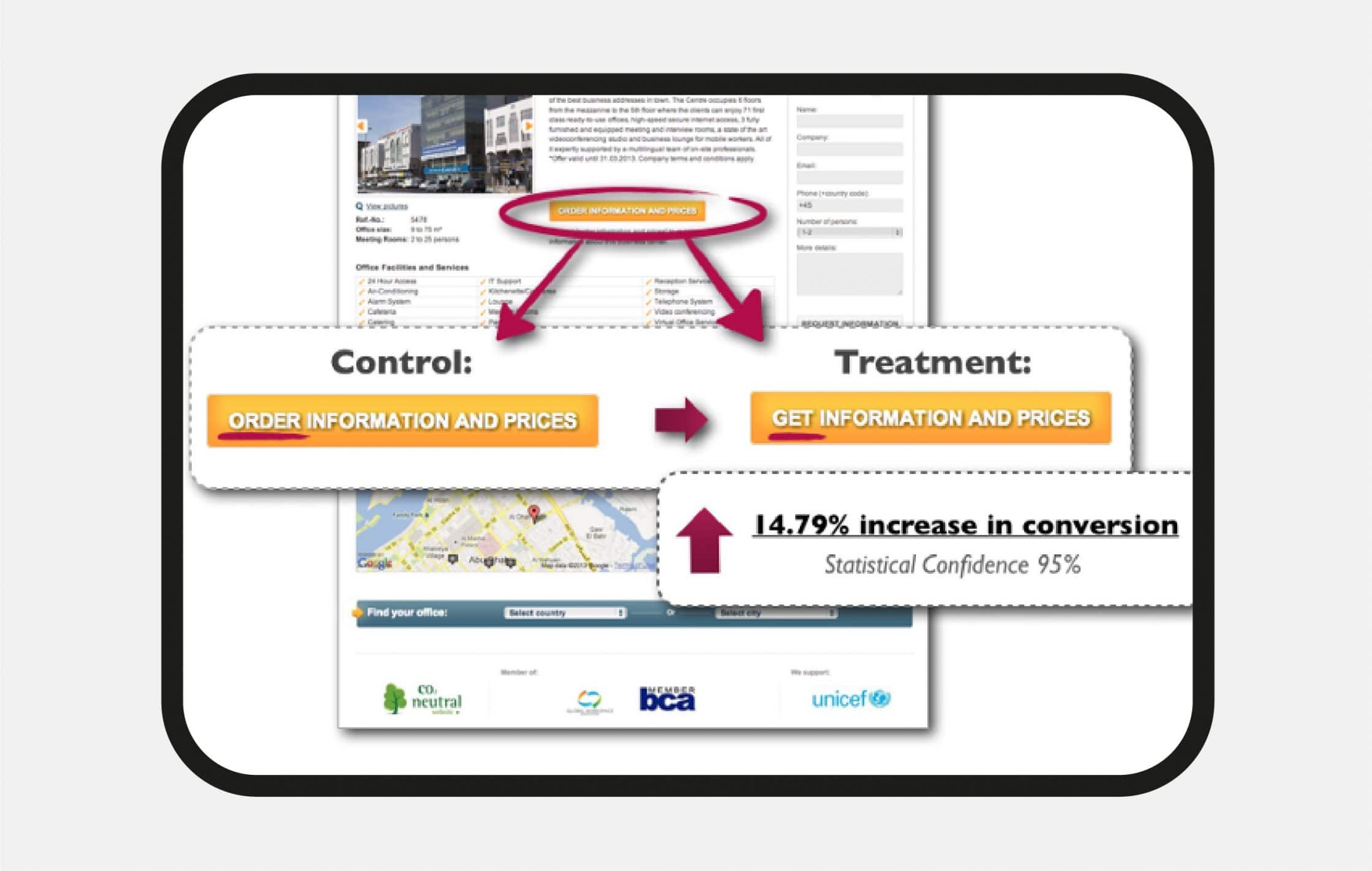
Every element on the landing page, no matter how tiny makes a difference – a huge difference.
3. Setup and analyse autoresponder
Your autoresponder and the content that you send to your list drives sales. The visitors who opted for the lead magnet are on your list. You now have to sell the tripwire and then the core offer.
Autoresponder does two things:
- Nature leads
- Turn prospects to customers
To begin, map your entire email sequence for the conversion funnel.
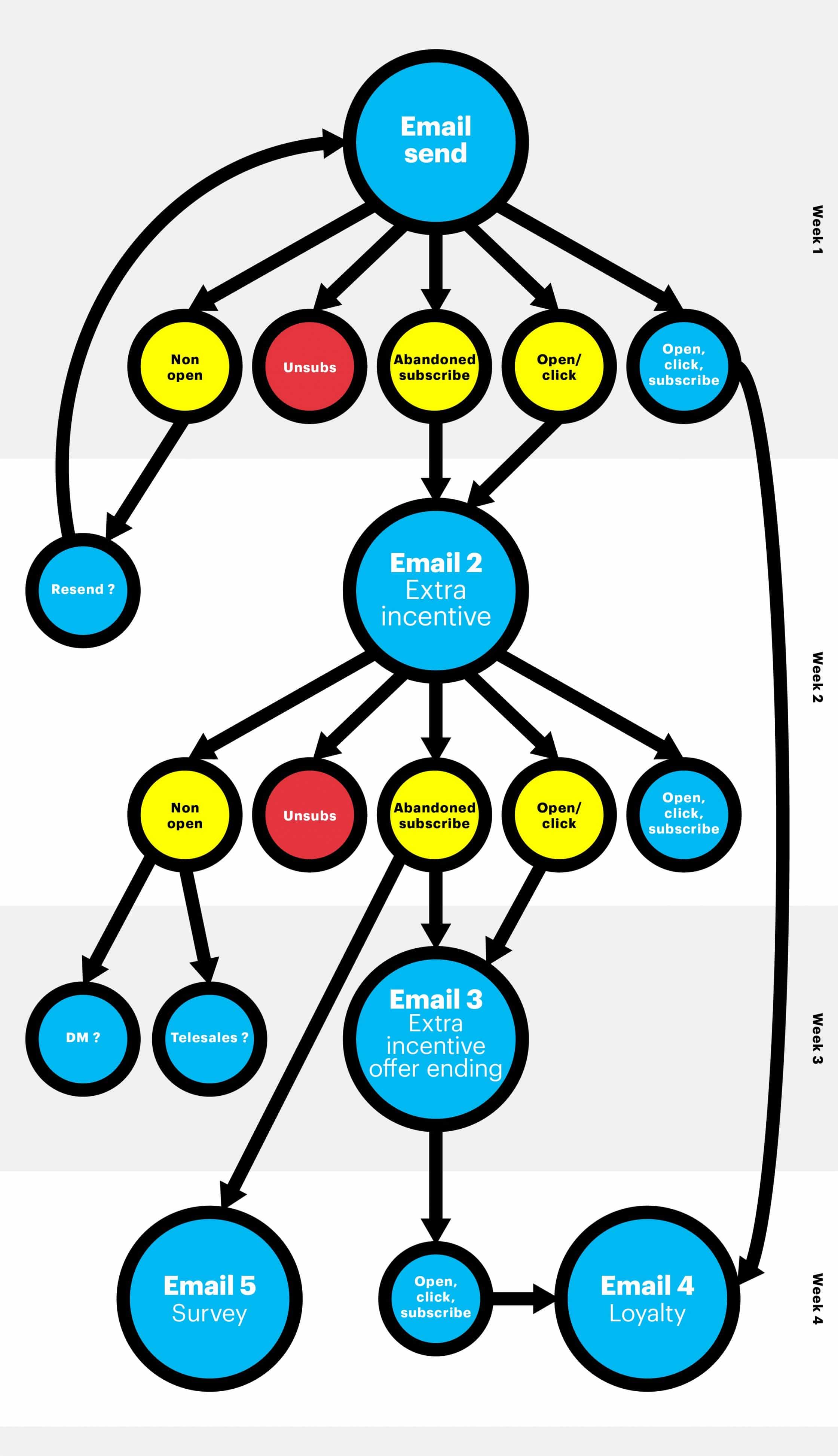
Creating the sequence is hectic but setting it up in the autoresponder is easy. Once you have a sequence map and have written the email content, it will continue to work on autopilot.
For instance, if a subscriber doesn’t buy a tripwire, what will you do next? What type of content will you send to these subscribers to convince them to buy the tripwire? If they don’t buy after several reminders, what should you do?
All such questions are to be answered by the autoresponder map.
The important question is what type of content to send at different levels of a funnel and how often to send the emails.
Promotional email copy doesn’t work — instead, informational email copy is what converts. There are different types of content that you can send to your list to increase conversions.
- Articles and blog posts
- Case studies
- FAQs email
- Quick tip(s)
- Proven content
- Videos
- Images and newsletters
- Podcasts
- E-Books and guides
Every single email must:
- Be relevant to the offer you’re promoting
- Have an objective
In the meantime, there should be a segmentation map too. It would look something like this.

Overall, there must be multiple autoresponders, multiple segments, multiple landing pages, multiple offers, several lead magnets, and everything must be connected.
For instance, a subscriber who purchased Tripwire A but didn’t purchase Core Offer A after multiple reminders should be pitched Tripwire B.
Those who don’t buy Tripwire B should receive Survey autoresponder. Get insights and ask the reasons why they aren’t buying the products. After the survey autoresponder, move them to a new low-price customised offer.
This is how autoresponder should work at the backend of every funnel.
Ideally, your subscribers should never stop getting emails from you. If they do, you’ll lose customers.
Always analyse open rates, CTAs, bounce rate, etc., of your emails. Ask questions. Run A/B tests. Crunch numbers to better understand your customers’ behaviours.
Analyse and take actions to improve conversions.
For instance, if the open rate of an email in the series is too low than the average open rate of the entire sequence, consider changing the subject because it’s not making people click and open the email.
4. Use the right content for different funnel stages
Supplying the right type of content to the visitors based on their level in the conversion funnel will help with increasing conversions. It’s the best way to optimise the conversion funnel.
Think of a visitor who just saw your website for the first time, what type of questions he might have in his mind?
Obviously, something related to your company, products, and how your products can solve their issues?
Someone who has purchased the tripwire might not be interested in your brand and how you can help, he already knows it. He might be interested in the core products.
This is the type of content that you must use throughout the funnel.
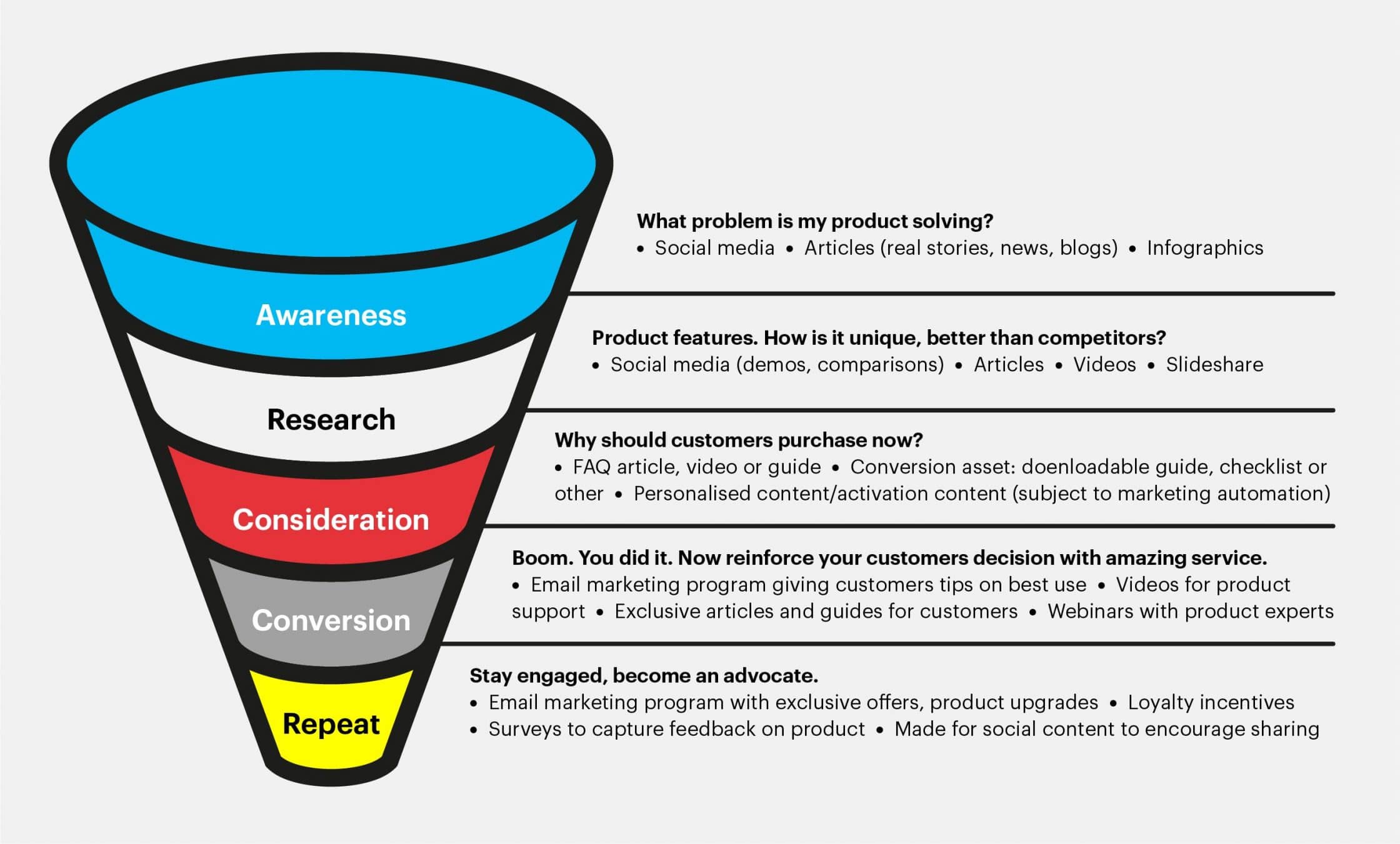
There are three stages of a conversion funnel:
- Top
- Middle
- Bottom
The content requirements for someone at the top of the funnel are different than someone who is at the bottom of the funnel.
Suitable content for the top of the funnel: Education content that makes the visitors aware of your business, products, and philosophy. The content type includes blog posts, eBooks, viral social media posts, guides, and videos.
Content for the middle of the funnel: This is the stage where a subscriber knows you and has opted for the lead magnet. Your objective is to convert subscribers into customers so this is the stage where you’ve to tell about your products, unique selling proposition, and tell them as much as possible about your products.
The most favourable content type for this stage includes FAQs, customised content, case studies, demo videos, product description, and in-depth guides.
Content for the bottom of the funnel: At this stage, there is one goal, to make a sale. The best content for this stage is product reviews, testimonials, and detailed product descriptions.
Zapier uses a demo at the bottom of the funnel where it offers a Free Forever plan to its subscribers. All the customers who opt for the Free Forever plan are cycled back to the middle of the funnel where they’re pitched with the premium plans.
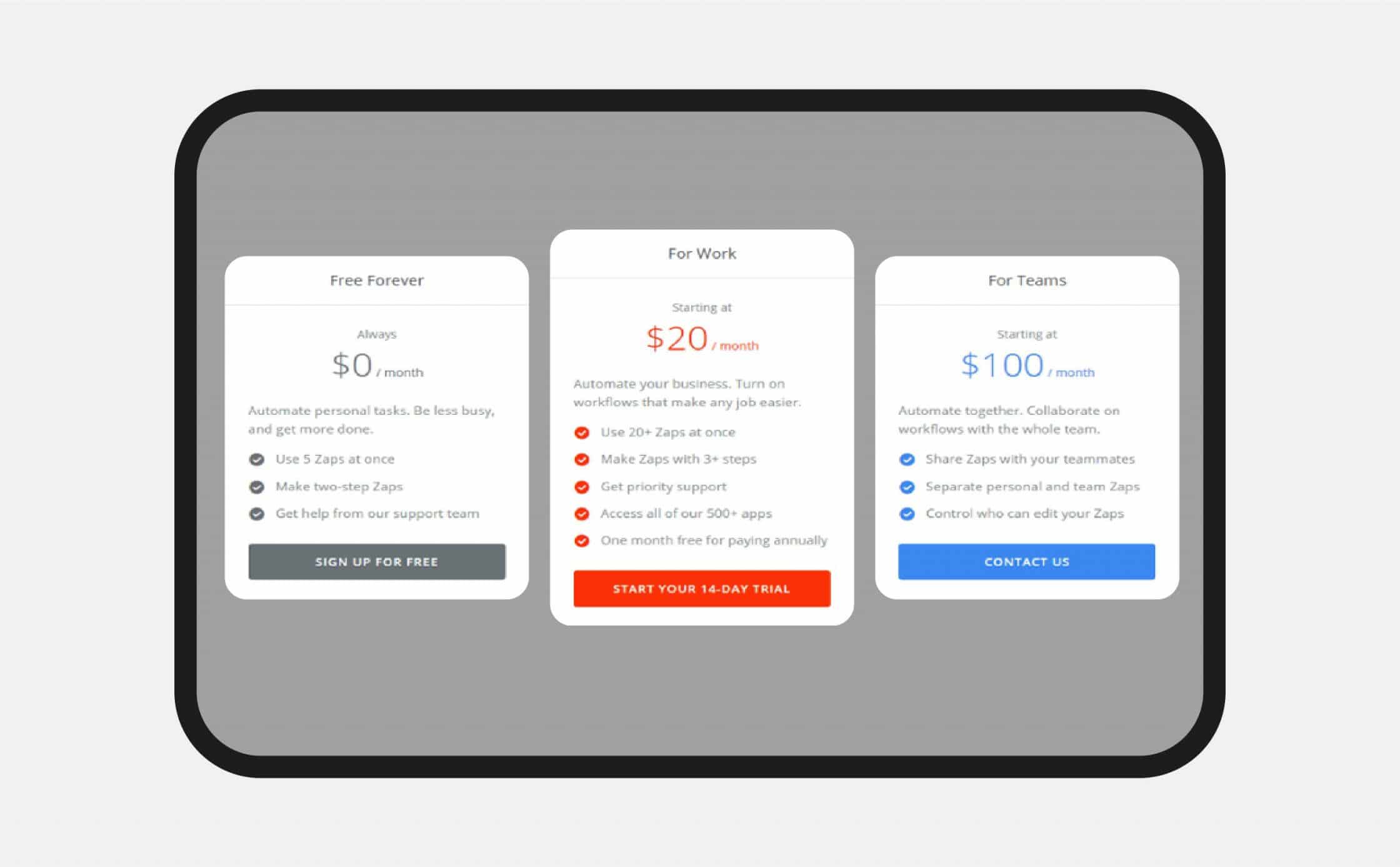
Campaign Monitor, on the other hand, uses how-to blog posts and in-depth help desk articles at the bottom of the funnel to show their subscribers how simple it is to use Campaign Monitor.

Relevant content that helps visitors in making the right decision increases conversion rate and reduces funnel leakages.
5. Optimise your website
Conversion funnel optimisation is significantly associated with your website. All the transactions take place on the website.
Imagine having a well-structured and fully-optimised conversion funnel that’s filled with relevant content and autoresponders but the website is poorly designed.
During the awareness stage, visitors will explore your website. A poor design will turn them away.
BuyaKilt, an online kilt retailer, tweaked the design of its product page which resulted in a 26% increase in conversions and 76.1% increase in revenue.
They simply added the product filters that allowed the users to narrow down product search.
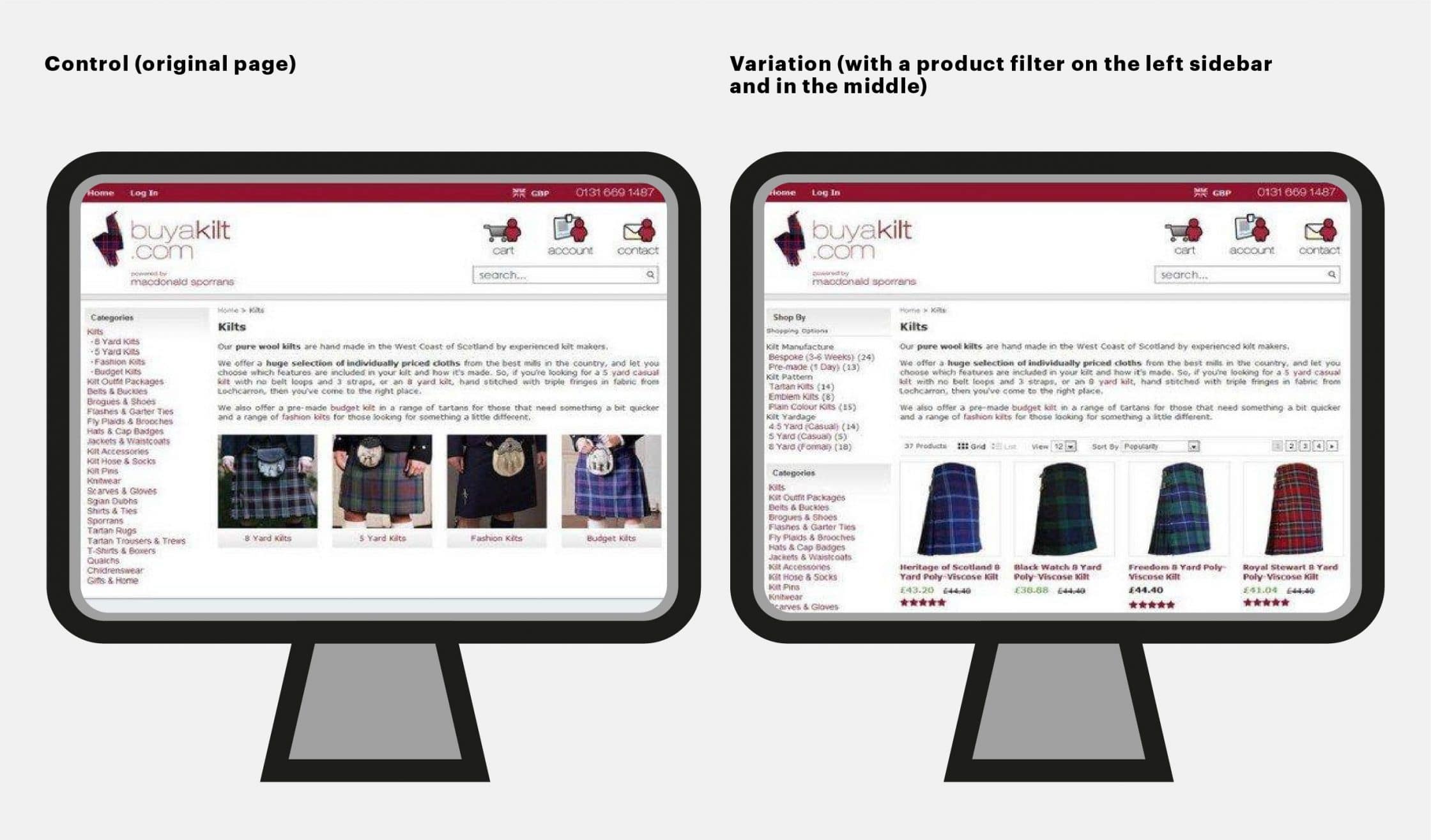
Taloon is a hardware eCommerce store that boosted its conversion rate by removing the social share buttons that are otherwise, supposed to be liked by online shoppers.

Anything as tiny as breadcrumb or as large as a website layout will definitely impact conversions. While you’re busy tweaking your funnel, products, and content for an increase in conversions, don’t miss your website.
So how’d you know what elements of the website must be changed or tweaked to increase conversions?
There are two stages to making your website fully optimised.
- Follow all the website optimisation best practices.
- Tweak your website for improvements.
To begin with, here are the best practices that will help you optimise your website for your audience.
- Use a unique design.
- Make it visually pleasing and professional.
- Make it load fast. The average load time should be no higher than 3 seconds.
- Move all the crucial elements above the fold especially CTA.
- Use margins to enhance readability.
- Use responsive design.
- Use short paragraphs, bullets, and subheadings to make it reader-friendly.
- Use a decent color scheme preferably black and white.
Once your website is ready, you must constantly tweak it to see what works and what doesn’t.
For instance, run an A/B test to find the best color scheme for your website. Create multiple variations and see which one of the best converts better.
Use it.
Then run another series of test to see what works better:
- A single product image
- A 360-degree product image
- Multiple product images
- A product image and a video
- Product video only
- Multiple videos and multiple images
These tests will give you information that you’ll not find anywhere else. You never know how your audience will respond to a change in the website as compared to the audience of some other website in another industry. The only way to find out if something will work for you is to try it.
You can keep testing your website for an endless period of time. There’s no end to it. As long as you see results don’t stop.
Pro tips to conversion funnel optimisation
The conversion funnel optimisation strategies discussed in the previous section are enough to get all the love and trust from your target market. But there’s still a lot more to conquer.
Below you’ll get exclusive access to conversion funnel optimisation tips and tricks from the experts.
Tip #1
Molly Pittman from Digital Marketer shares a great way to fix a leaky funnel with a Facebook retargeting campaign.
Here is how it works:
If a visitor downloaded the lead magnet but didn’t purchase the tripwire, you’ve to use Facebook retargeting ads to pitch tripwire. Though you have the email address but a customised retargeting ad will help generate the sale.
You’ve to develop the interest of the potential buyer in the tripwire. Maybe, offer a discount on tripwire or use an alternative tripwire that is more appealing.
Similarly, if a customer purchased the core offer but didn’t purchase the profit maximiser, a retargeting campaign should develop the customer’s interest in the profit maximiser. Tell him how beneficial it is.
The idea is to remind them and get their attention again through a Facebook ad.
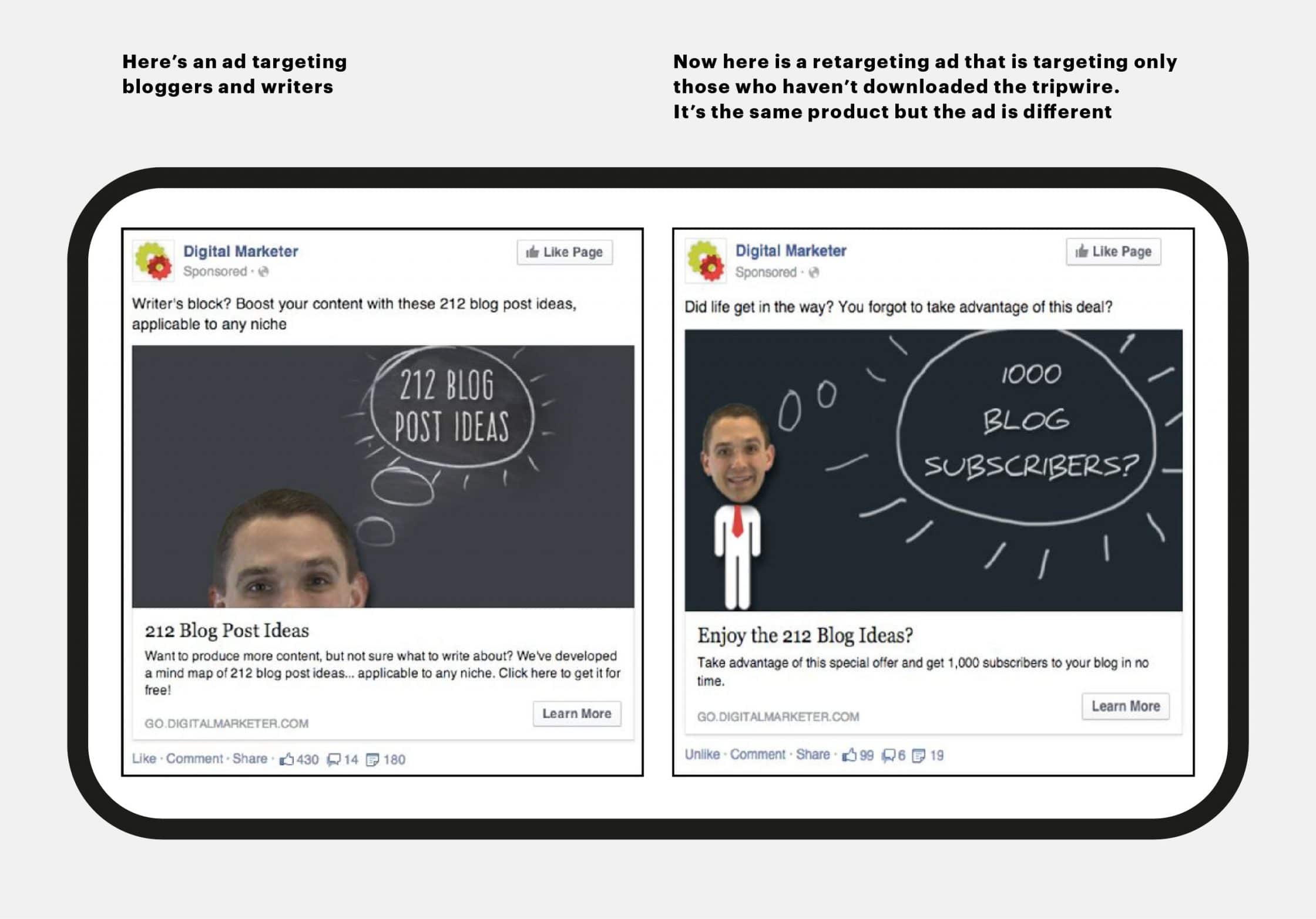
Fill your entire conversion funnel with this type of retargeting ads so as to make it leak-proof.
Tip #2
Use simple signup forms.
This tip comes from Neil Patel via Amanda DiSilvestro.
GrubHub uses a dead simple signup form that only asks for the email and the password. The users don’t have any other choice but to sign up.
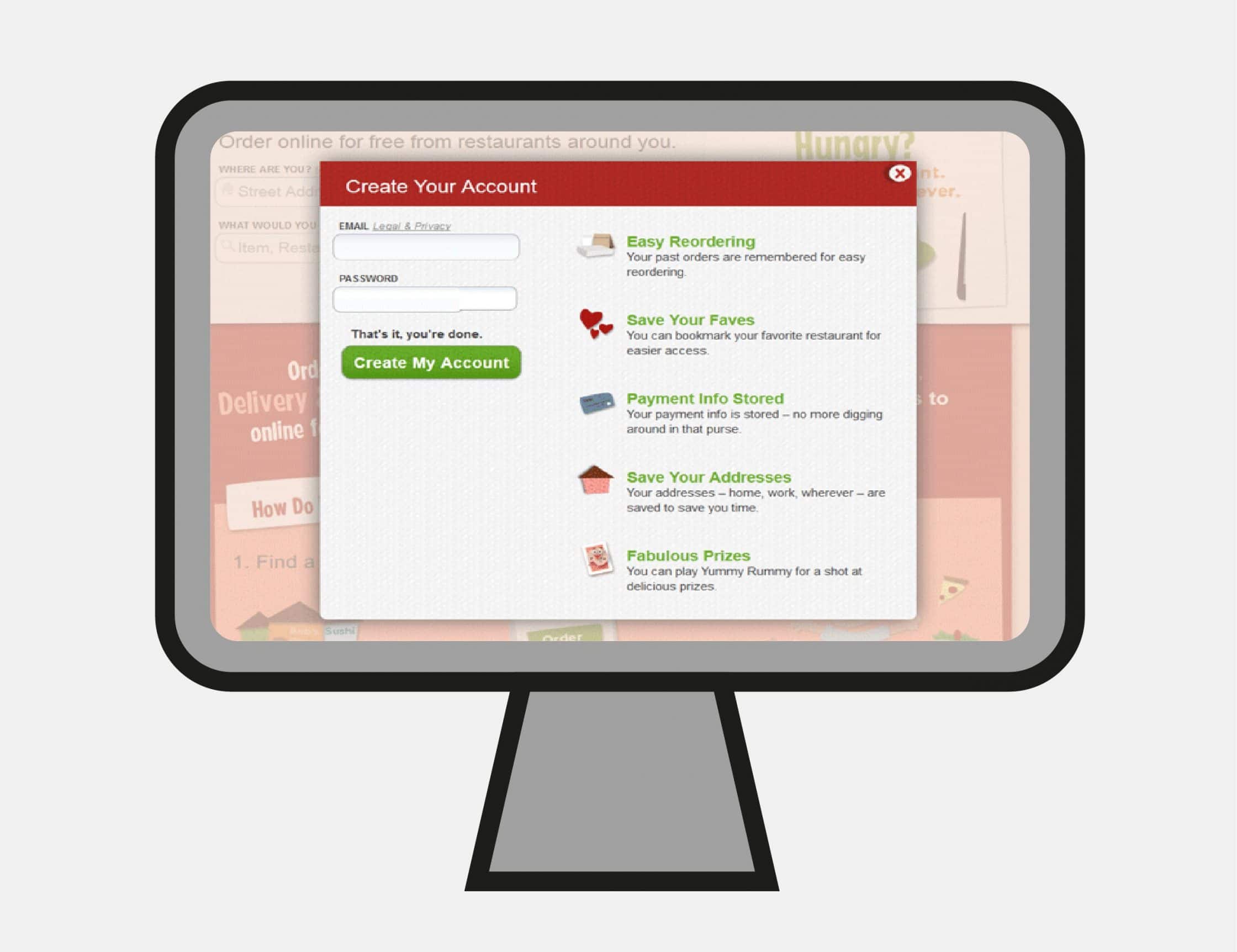
Neil Patel tested the simple signup form on his website KISSmetrics and saw a 59.4% increase in sign ups and 30% increase in revenue.
The thing is your target audience don’t have the time to insert their information onto every other website they visit. If you want them to give their information, better make it simple and quick. Long forms asking for information that you might never use is nothing but a waste of time.
Ask for the name and email address.
Simple.
Better yet, use social logins to boost conversions as 77% users reported in a survey that they prefer social login as a registration method while 86% said that creating a new account on a website by entering details bothers them.
Tip #3
This one comes from Lars Lofgren who is a Marketing Analyst at KISSmetrics.
Reduce the steps in your funnel.
Keep it simple.
Shopify has a simple two-step checkout.
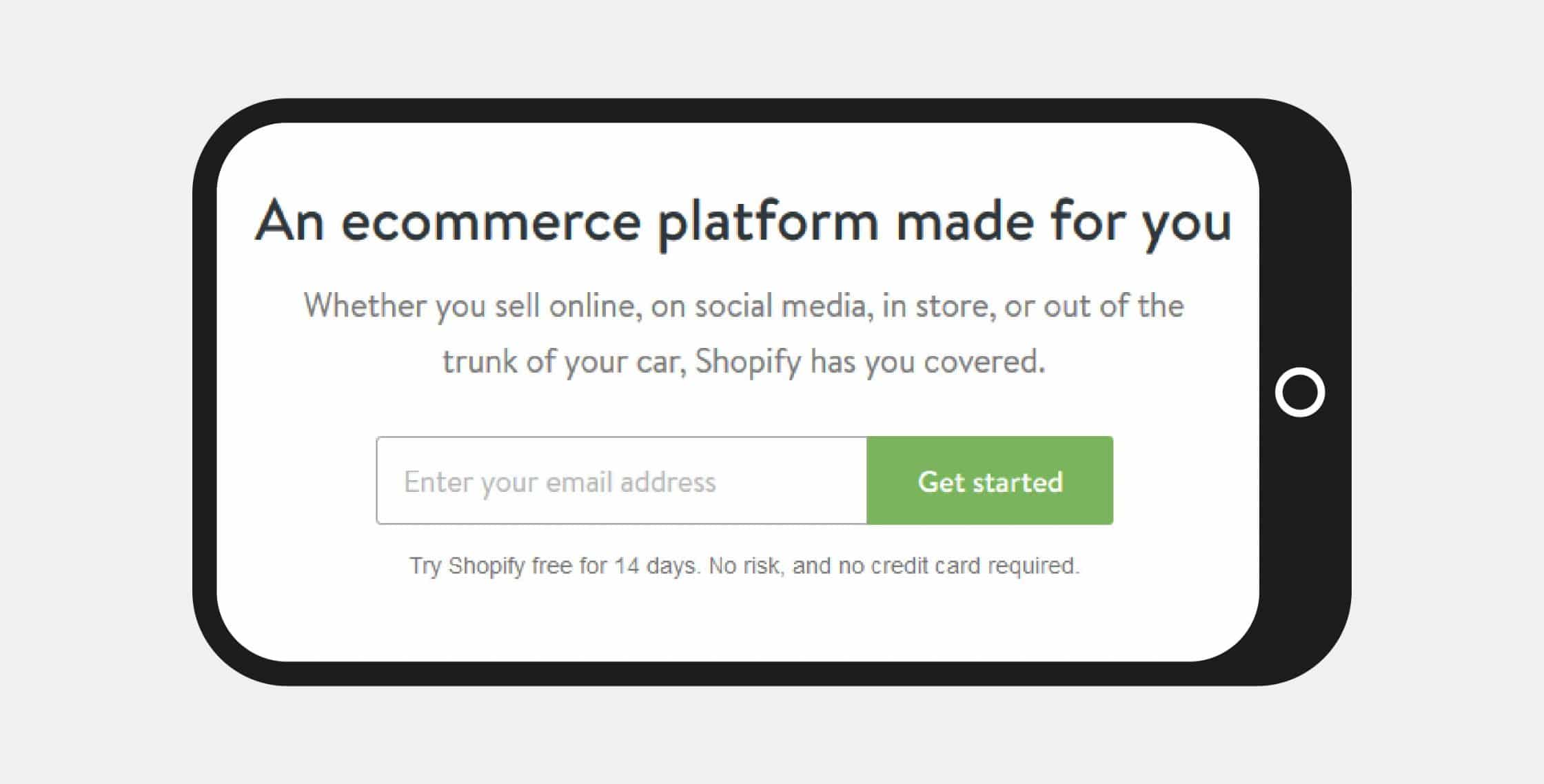
Amazon equally has a 2-step process.
If you want to decrease funnel leaks and make sure that all the visitors who enter the funnel make it to the bottom of the funnel, keep it simple and straightforward.
Remove all the steps and phases that you can. Of course, it might not be possible with all types of funnels and for all types of brands.
If you have a new business, you need a lot of funnel stages so as to guide customers and to gain their trust.
Amazon, for instance, when started had 7 steps in its checkout process. Today, it has been reduced to only two. It didn’t happen overnight. Today, Amazon doesn’t have a trust issue. Everyone knows it.
Brands that are new and unknown can’t do it because they have to add social proofs, customer reviews, FAQs, and several other content types to gain the trust of the customers. But as time goes by, you can remove the steps and shorten the funnel to make sure everyone gets to the bottom almost instantly.
Conclusion
Whether you believe it or not, every business has a conversion funnel. The question isn’t about creating one, it’s about optimising it.
Businesses that optimise the conversion funnel for conversions and improvements outperform their counterparts.
Optimise your conversion funnel or just leave it the way it is. Decide what you want to do now. Yes, optimisation seems to be a lot of work but it is worth the resources and time. You’ll never regret spending money, time, and resources on your conversion funnel.
If you enjoyed this article, you might enjoy these ones too:
– The psychology of landing page design that converts leads into customers






